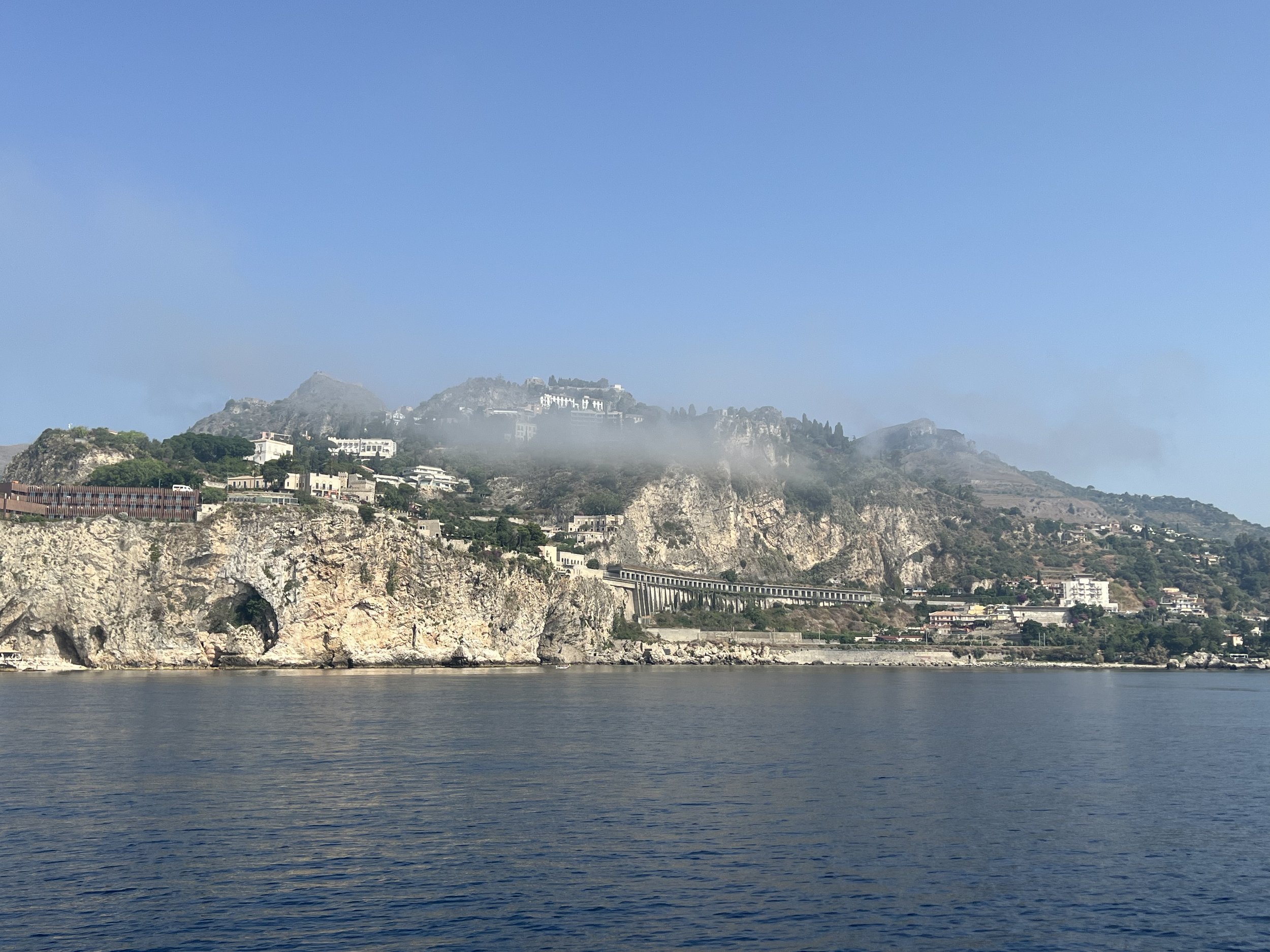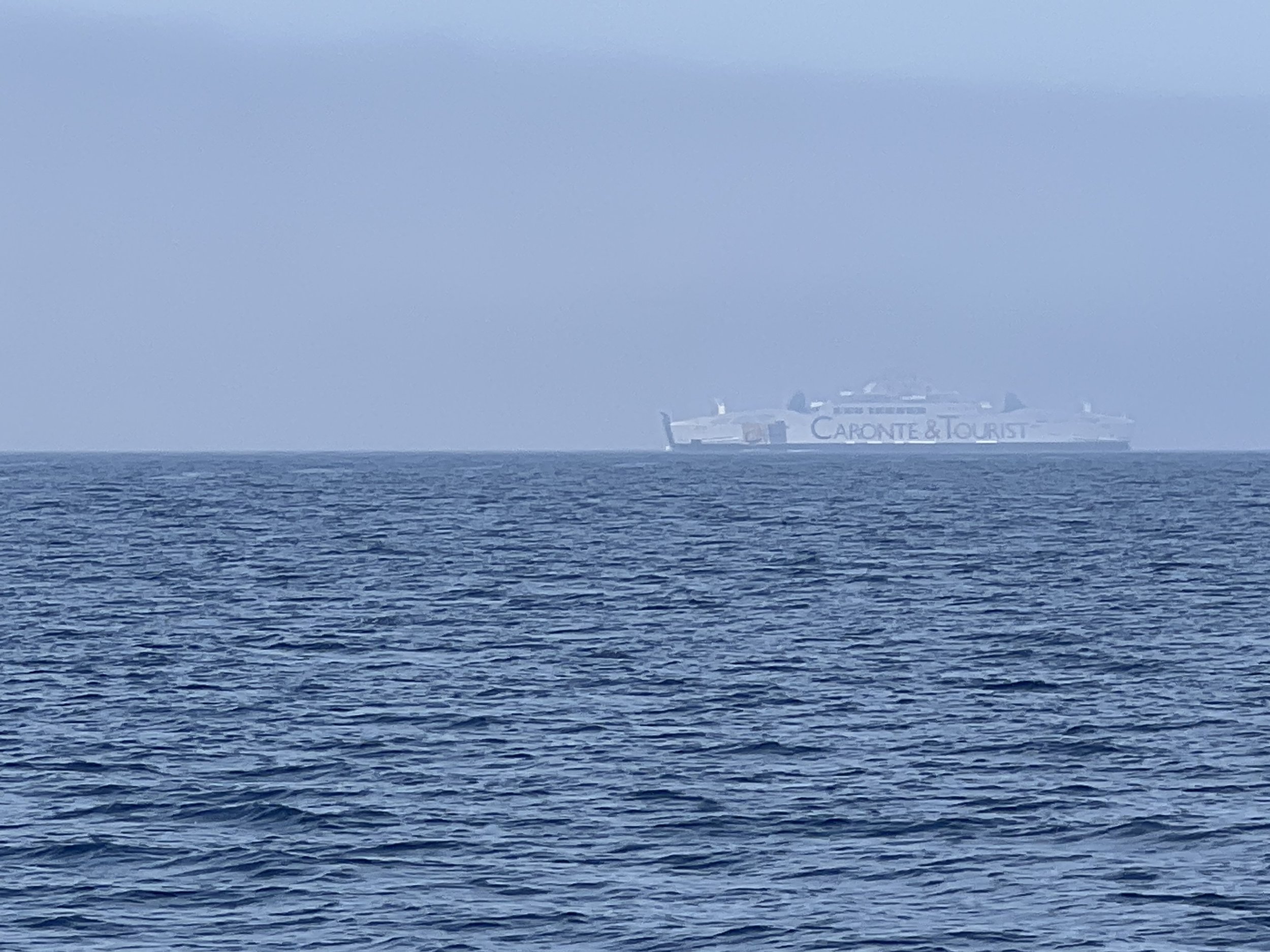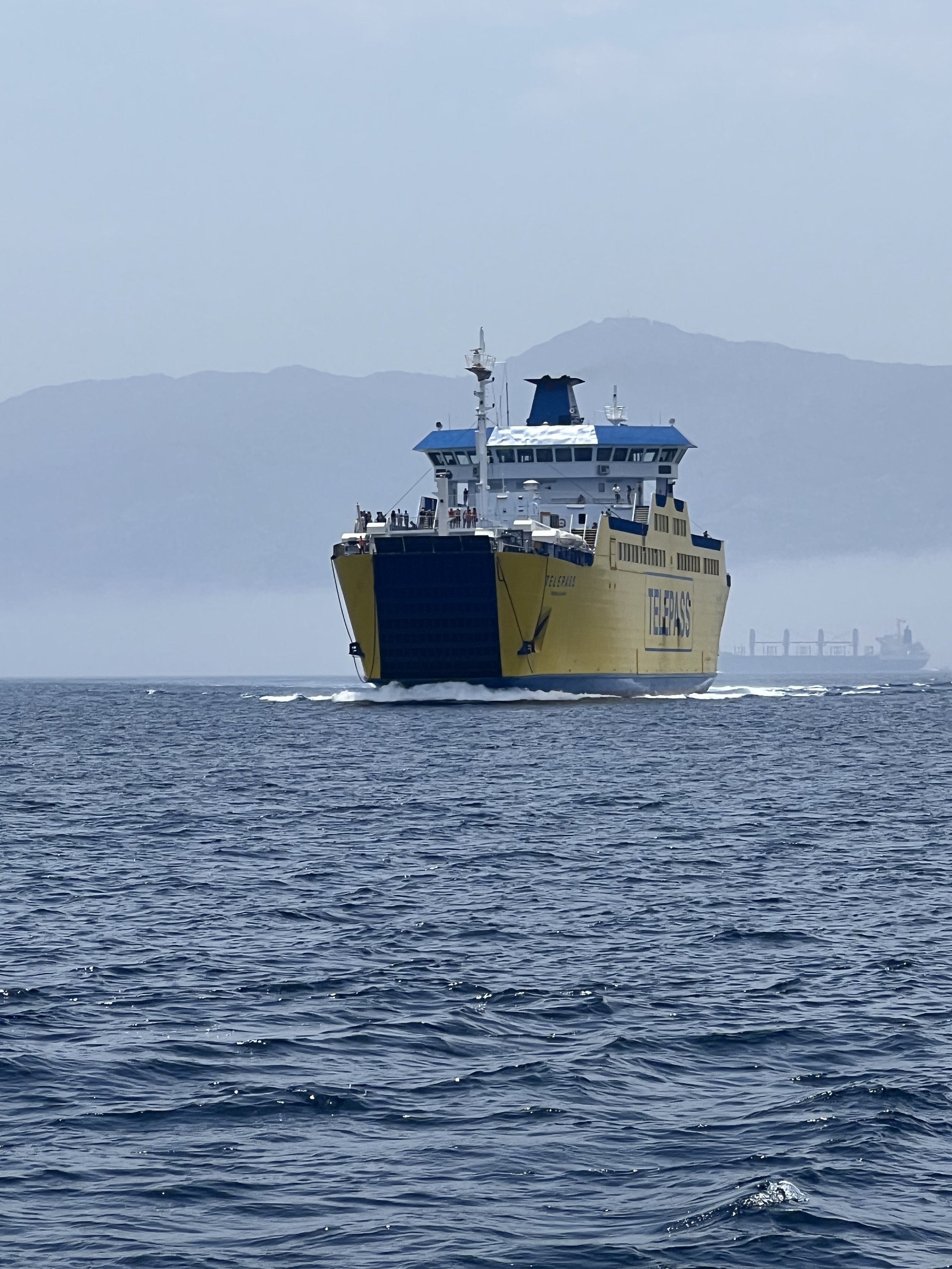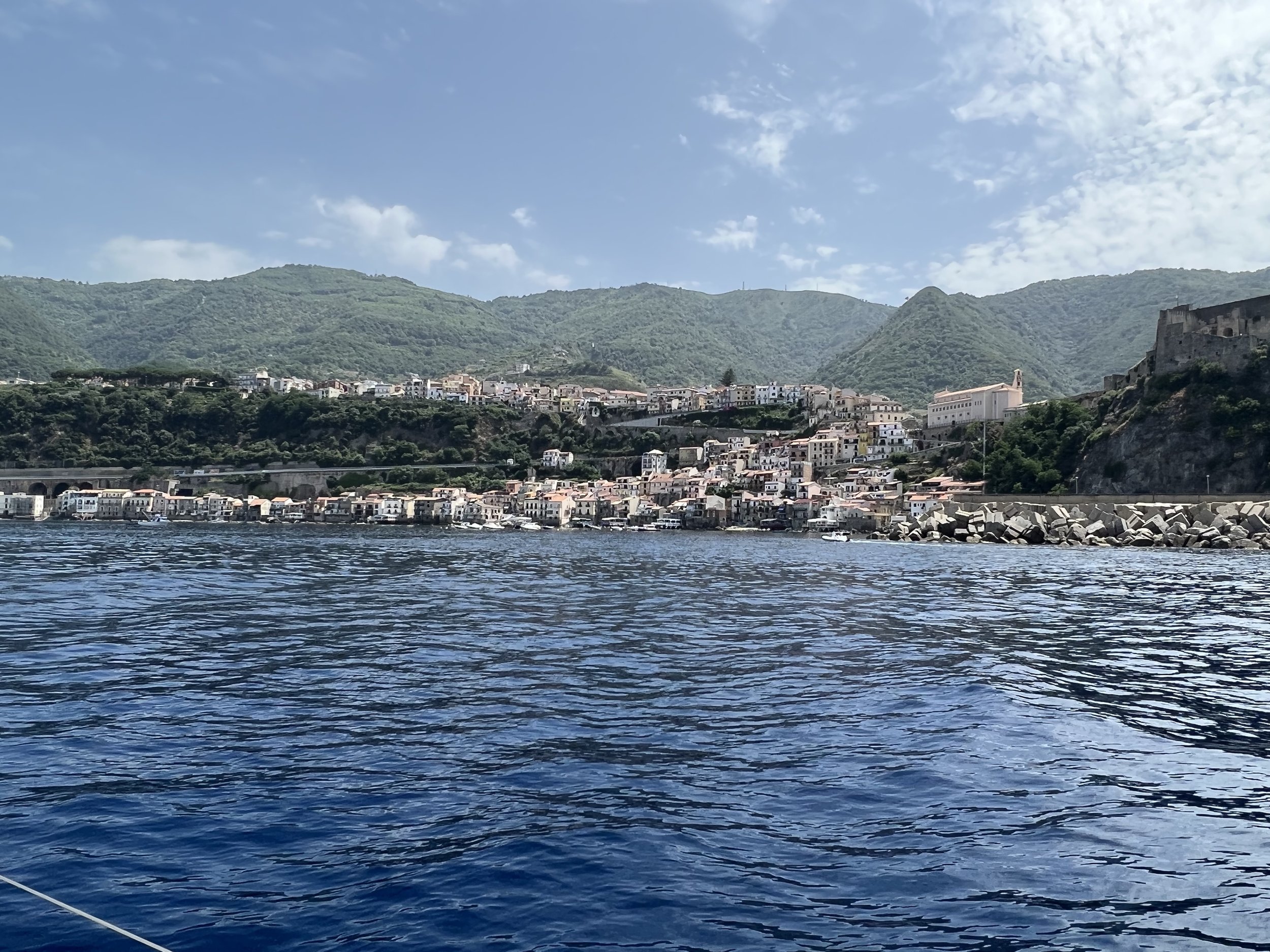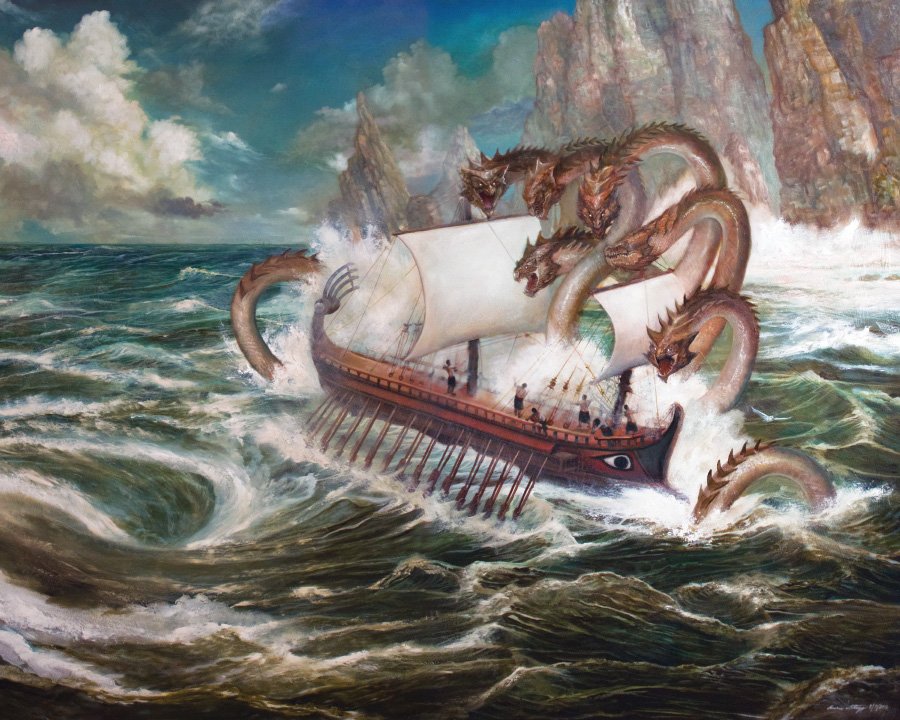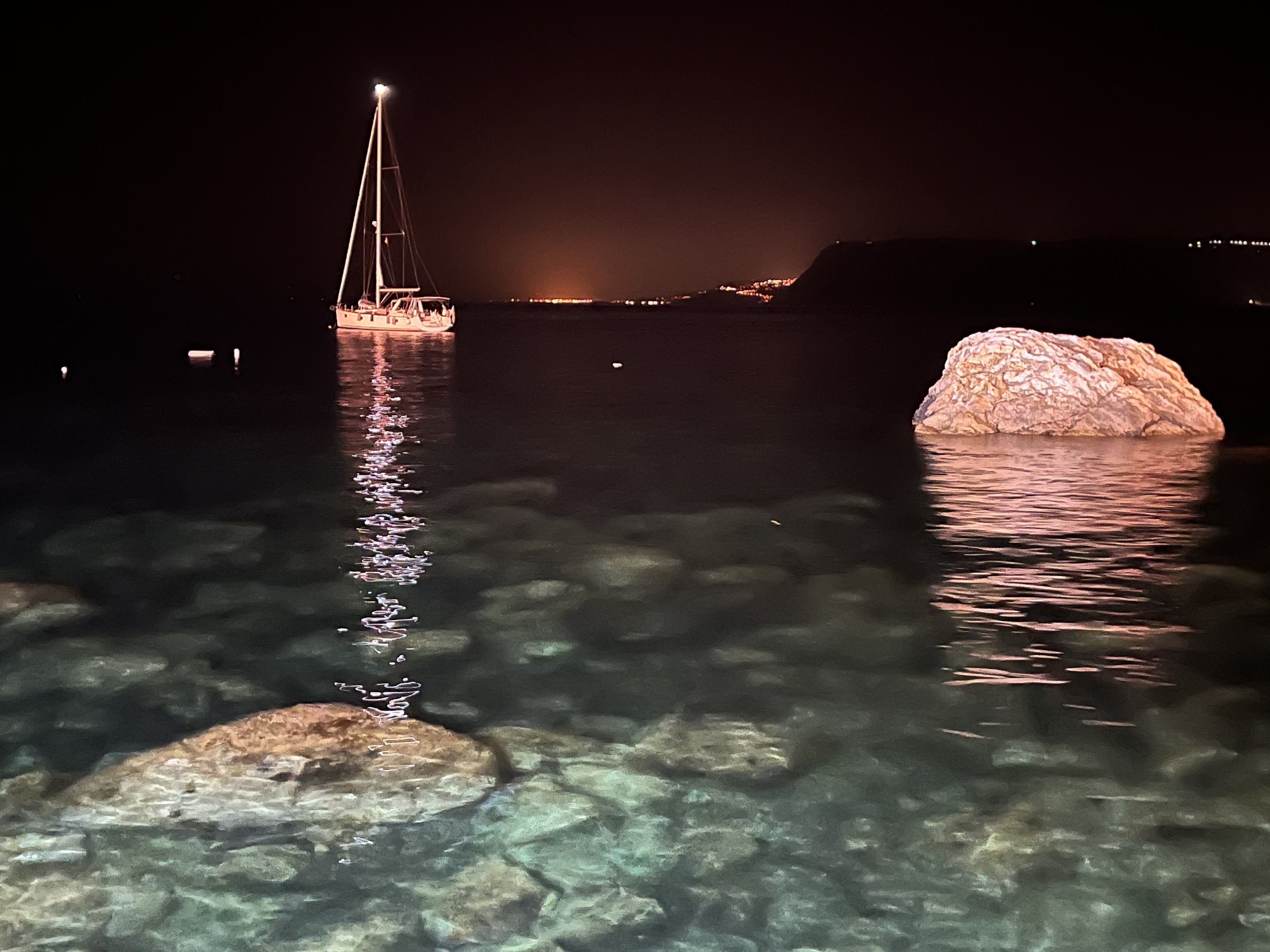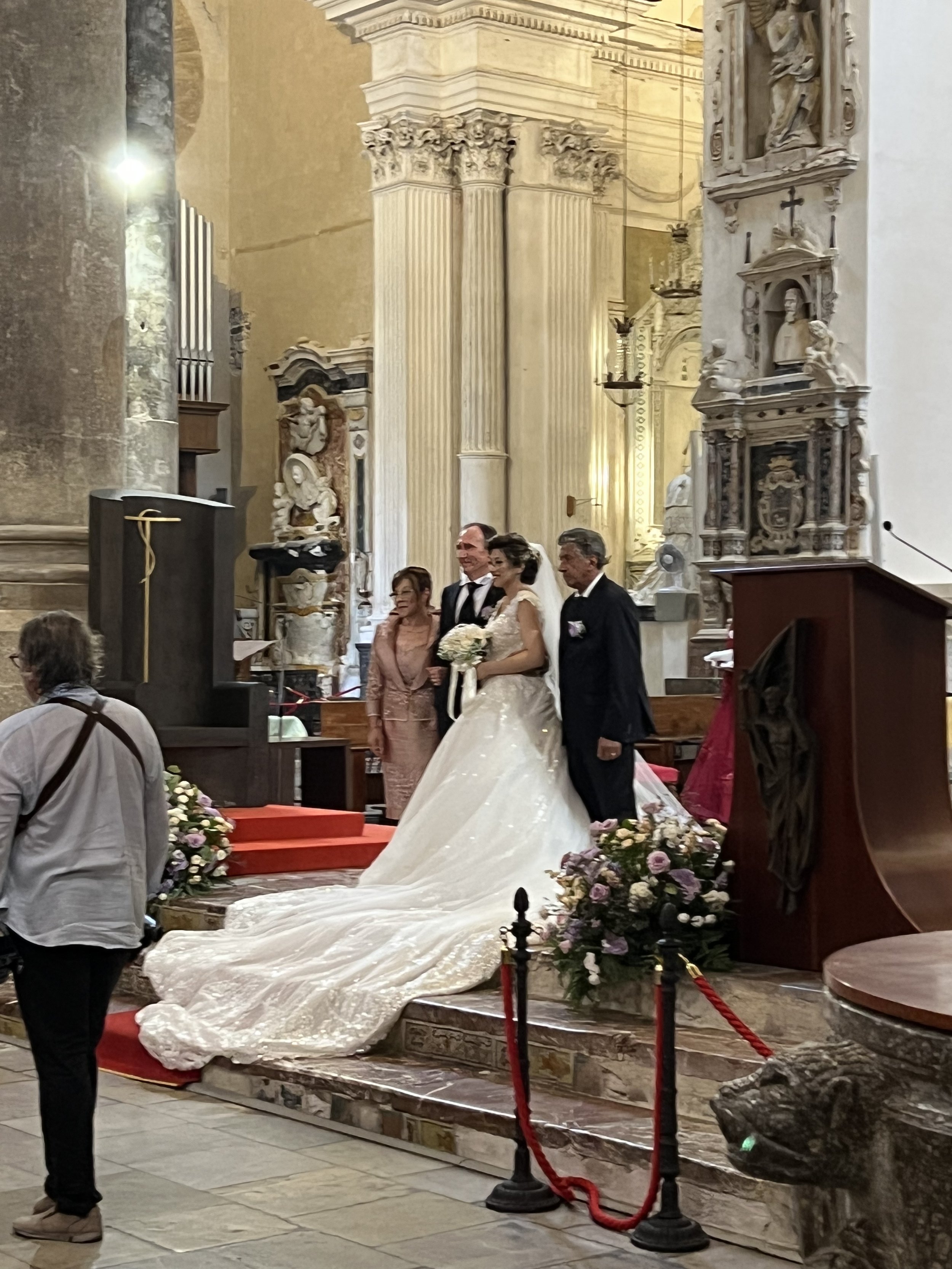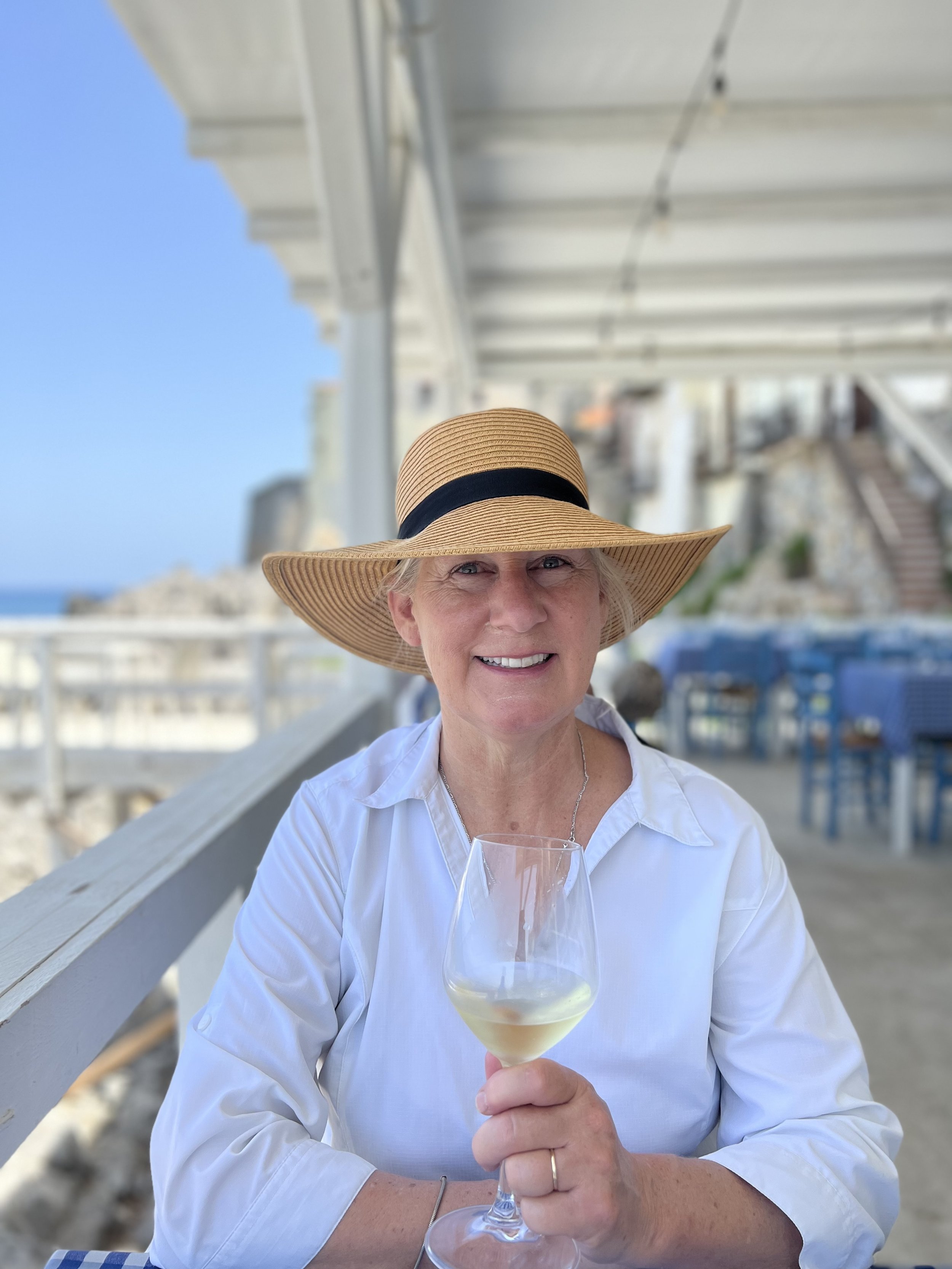Getting from the Ionian Sea to the Tyrrhenian Sea and the north of Sicily involves passing through the Strait of Messina. This can be a tricky piece of water due to the structure of the seabed and the narrowness of the channel itself. The two seas, one to the north and the other to the south, are both deep but have different characteristics and the water that moves between them is forced to take the narrow, shallow channel that is the strait itself. Weather and sea state can be unpredictable.
We’ve taken the south-north route a few times and it’s never been the same twice. And this time it’s setting us up for something different again.
We have chosen a weather window that promises a straightforward passage, but as we set off we hear that the actual conditions are less than ideal. At the south end the weather is fine; at the north end it is blowing hard; in the middle there is fog. This should be interesting.
The first part is easy - hot, hazy and calm with visibility generally good but definitely variable. As we move northwards the visibility stays variable but deteriorates significantly. We are starting to move into the fog.
Our AIS can identify the location of boats that use this technology but not everyone is required to and not everyone does. So as our ability to see diminishes, the risk of us having a close encounter with another vessel increases sharply.
Most of the traffic in the strait is RO-RO ferries going ACROSS the traffic lanes - there are no traffic lights; there is only one roundabout; boats don’t have lights that help in fog; nobody can see very much at all.
The ferries are quite large but frustratingly invisible until we turn on our radar. Suddenly we can see all the vessels that are close to us, plot their course and assess their risk to us. Those with radar can also see us.
But it’s still a bit spooky. On the radar we see a ferry about half a mile away heading into our path; looking up we can see nothing. Slowly a dark line emerges from the mist and we are relieved that it’s only a small ferry. But wait, more and larger details emerge and we can see that it is actually one of the larger vessels moving fast into our path. “Large” is not so good, but “fast” is beneficial - it quickly moves ahead of us and we can focus on the others that are in range.
At the same time, the water takes on a disturbed nature with short sharp irregular waves that knock us about a bit but don’t pose any real threat. The conflicting water flows mess with our boat speed too - without changing our throttle the boat speed varies from three to almost eight knots.
We eventually pop out of the north end of the strait and make a sharp right turn to the little fishing village of Scilla. Regular readers will remember that Scilla gets its name from that of the sea monster Scylla in Greek mythology. The story here is pretty special.
It all starts with Glaucus, a mortal and general good guy. One day he comes across a herb that can bring things back to life. (Though exactly how you decide that giving a dead animal a piece of shrubbery is a gainful way of passing the time I don’t know. He must have been really bored.) Anyway, he thinks what would happen if I ate it? (Again the logic here leaves something to be desired.) Turns out that it makes him immortal with one teensy snag. It also turns him into a fish-like creature, some kind of merman. But it’s ok, the other sea-gods take him under their wing (or should that be “fin”) and teach him all he needs to know. Glaucus fall in love with a cute sea creature called Scylla but she doesn’t think much of him.
So Glaucus goes to the sea nymph Circe for help (big mistake). Circe falls in love with Glaucus and poisons the pool where Scylla bathes and she is turned into a six-headed dog monster who really doesn’t like ships sailing in the strait. So she destroys them. I don’t know what happened to Glaucus.
Anyway, it’s tales like this that pretty much substantiate the claim that the Ancient Greeks invented daytime television.
Modern Scilla is still a small village with a thriving swordfish fishing fleet but is transforming itself slowly into a picturesque little vacation spot with some excellent (fish, of course) restaurants (one of which has a nice night time view of True Colors).
We next make a quick side trip to the Aeolian islands off of the north coast of Sicily. This gets us close to a pretty active little volcano that forms one part of the arc of four volcanoes in this region - Etna, Vulcano, Stromboli and Vesuvius - all four are active.
We spend the night moored within sight of Stromboli (Lori thinks this is close enough) on the island of Panarea - a car-free island that is a curious mix of day trippers and exclusive establishments that cater to their upscale guests who arrive by superyacht or helicopter.
We head back towards the mainland threading our way through the other islands. We’re motoring through one of the channels minding our own business and a French guy yells at us. Can’t hear what he’s saying and can’t see anything on our boat that we should attend to. It remains a mystery so we put it down to the heinous crime - “sailing while not French”.
The trip from the islands to the mainland is a beautiful sail with the steady wind pretty much on our beam - smooth sailing!
Cefalu, on the mainland, is another fishing village which is farther down the road to “main tourist destination.” This primarily due to its superb Norman cathedral.
But before we can visit the town, we have to park the boat. Not usually a major problem.
The little tourist port at Cefalu has one serious drawback - it is not completely protected by harbor walls. It is open to wind and sea from the east. Guess what we’ve got today!
Our pontoon is completely open to the swell; each big surge pushes us about two feet backwards towards the quay. This makes putting lines ashore very tricky. Also the boat is rolling from side to side which makes the spreaders on our mast come perilously close those of the boat next to us.
This makes for a difficult three-dimensional problem which the marineros are eventually in control of and do a great job. But it is not safe to try to get off, so we spend the evening and night on board and will explore Cefalu tomorrow.
I don’t think I’ve mentioned it so far, but it has been really hot since we arrived in Italy. “Extreme heat” warnings have been continuously in place since we got here. It’s not Scottsdale hot temperature-wise but the humidity has been pretty cruel. So the 20-minute walk into town is fairly demanding and very sweaty.
But it’s worth it.
Cefalu still has its original street pattern with narrow cobbled alleys leading either to the sea or the cathedral square.
It’s Saturday so, as we’re starting to realize, it’s wedding day anywhere there’s a cool church for the service. We wondered if the elaborate dresses from Taormina would be a little toned-down in a less glitzy place. But this is Italy, so what do you think?
Another wonderful thing about the Italian approach is that your church may be an historical monument, an architectural masterpiece and contain priceless works of art, but, yes, you can book it for your function.
The downside of this frenzy of weddings is that I don’t get to take the pictures I’d like. My Italian doesn’t stretch to, “If the bridal party would just step aside for one moment, I can get a better shot of the mosaic in the apse.” Probably for the best. Darn!
Faced with a crisis like this, we resort to a centuries-old Italian remedy: we eat lunch.
This doesn’t make the problem go away, but you do feel a lot more mellow about it! And you have time to reflect on possible solutions. I resolve to get up early the next morning and scoot into town while it’s cool. The church opens at 8:00am about 90 minutes before the first mass. (Fortunately early mass doesn’t seem to be a thing here.)
I make the trip as planned and am walking in the almost deserted streets of Cefalu at about 7:30. Suddenly a long-forgotten European stereotype confronts me - I see small groups of people with beach chairs, towels etc. making their way to the beach. It is the great quest for “The Best Spot”. It’s 7:30 in the morning people! (And by the way when you get there you’ll see that the local grannies are finishing their swim and are on their way home for breakfast. I like their plan better.)
With few people around you can get to appreciate some of the never-changing sights of rural and small town Italy. First of all, there are little shrines scattered throughout the villages and towns. Some are showing their age but others are well-maintained and utterly charming.
Another timeless icon of rural Italy is the Piaggio Ape which has been in continuous production since 1948 and this may be one of the originals.
In this case, it is not the English “ape” we’re talking about, rather it’s the Italian “ape” which means “bee”. Entirely appropriate if you’ve ever heard the noise of their tiny engine and seen the way they buzz through traffic. By the way, Piaggio also made the Vespa motor scooter - “Vespa” is Italian for “wasp”.
The church opens a little later than advertised and I am worried that I might not have time to take the shots I want if there are a lot of people. But I need not have worried.
It is quite intimidating being in a cathedral all by yourself. But I kind of think that that is exactly what the architects of these buildings had in mind.
If you take away some of the renaissance features, the structure is imposing and austere - culminating in the mosaic of Christ Pantocrator in the apse. Warm and welcoming he is not.
But the whole building is dominant, assured and confident in its permanence. One of the most impressive churches we’ve visited.
And now it’s on to Palermo which has truly wonderful churches in its own right.
